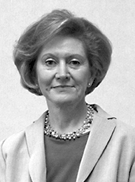Nancy M. Gordon: Informing Decisions
Val Snider, ASA Publications Coordinator
“The technical challenges and statistical issues we are facing are real and interesting.”
Nancy Gordon’s career has focused on providing unbiased and reliable information for decisionmaking. Early on, when she worked in academia and at nonprofit organizations and the Congressional Budget Office, her focus was policy-relevant analyses related to employment; federal tax provisions; and programs such as Social Security, Medicare, and those providing financial assistance for post-secondary education. At the U.S. Census Bureau, which she joined in 1995, data collection and dissemination have been her primary responsibilities.
Just the Facts
Education
BA in economics and statistics from the University of California at Berkeley
PhD in economics from Stanford University
Previous Work
Congressional Budget Office, Assistant Director for Health and Human Resources/Senior Economist, 1980–1995
White House, Senior Advisor to the Assistant to the President and Executive Director, Presidential Task Force on Women, 1979–1980
The Urban Institute, Senior Research Associate, 1976–1979
Carnegie-Mellon University, Assistant Professor, Graduate School of Industrial Administration, 1970–1974
Honors and Professional Affiliations
Fellow, American Statistical Association
Elected Member, International Statistical Institute
Member, various committees of the American Statistical Association
President, officer, and member, Worldwide Assurance for Employees of Public Agencies Board of Directors, 1982–1990
Chair and member, Committee on the Status of Women in the Economics Profession, American Economic Association, 1985–1991
The Early Years
Until July 2005, Gordon was the associate director for demographic programs, providing executive leadership for all the bureau’s household surveys. With an annual budget of $300 million and more than 800 employees, she led the production of data that today drives the allocation of more than $400 billion in federal funds each year.
She also led the bureau’s efforts to create the American Community Survey (ACS) and the Local Employment Dynamics (LED) Partnership. “I still meet for lunch with the four division chiefs—whose contributions were essential to achieving our successes during that period—and talk about the immensity of that work,” said Gordon. “That was not generally a decade of expanding statistical programs, so starting new ones was quite a challenge.”
To put into perspective just how challenging these undertakings were, the ACS is now an ongoing survey sent to about 3 million residential addresses annually that describes what the population looks like and how it lives. Ultimately, it helps communities determine where to locate services and allocate resources. “The ACS was initially tested with a sample from four counties,” said Gordon. “Today, it surveys the population throughout the U.S. and Puerto Rico, collecting information to meet the needs of federal programs about age, race, income, commute time to work, home value, and veteran status, among other topics.”
The LED provides details about America’s jobs, workers, and local economies. It integrates existing data from state-supplied administrative records with existing information from censuses, surveys, and federal administrative records. “The prototype program began with just one state, but it has grown to include the District of Columbia, Puerto Rico, the U.S. Virgin Islands, and all but two states,” said Gordon.



















